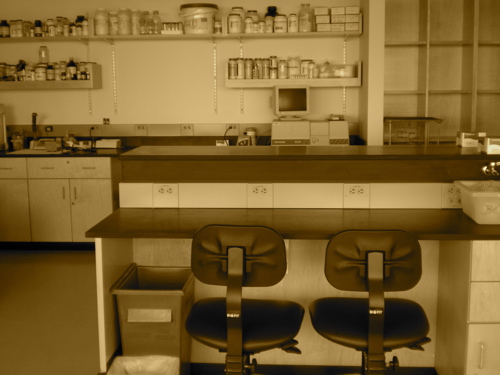20.109(S10):Prepare RNA by IVT (Day3)
Contents
Introduction
So far you have prepared the DNA encoding both the 6-5 and the 8-12 aptamer fragments. However, it is the secondary structure of the RNA that actually allows the 8-12 sequence to bind to heme. In order to make RNA from DNA, you will perform an in vitro transcription (IVT) reaction.
What is needed to create RNA from DNA? In PCR, you used a DNA polymerase and dNTPs to make your DNA. In an IVT, you will use an RNA polymerase and NTPs instead. The polymerase is purified from T7… The buffer conditions are also somewhat different (check out the reagent lists at the end of each day), but both contain the important co-factor Mg2+. Finally, an IVT contains pyrophosphatase, because it has been empirically found to increase efficiency.
Now let's consider how an IVT fits into the overall scheme of SELEX. (Get/make and describe figure.)
Because you are preparing RNA, you will have to take special precautions today and for the rest of the module. RNA is strikingly different from DNA in its stability. Consequently it is more difficult to work with RNA in the lab. It is not the techniques themselves that are difficult; indeed, many of the manipulations are nearly identical to those used for DNA. However, RNA is rapidly and easily degraded by RNases that exist everywhere. There are several rules for working with RNA. They will improve your chances of success. Please follow them all.
- Use warm water on a paper towel to wash lab equipment, like microfuges, before you begin your experiment. Then wipe them down with “RNase-away” solution.
- Wear gloves when you are touching anything that will touch your RNA.
- Change your gloves often.
- Before you begin your experiment clean your work area, removing all clutter. Wipe down the benchtop with warm water then “RNase-away,” and then lay down a fresh piece of benchpaper.
- Use RNA-dedicated solutions and if possible RNA-dedicated pipetmen.
- Start a new box of pipet tips and label their lid “RNase FREE.”
Qiagen sells a kit for isolating RNA and we will be using their protocol and reagents.
Or move above into protocols as usual?
The IVT will run during the whole lab period… In the meantime, we will discuss a journal article, both to learn more about RNA aptamers and to become comfortable reading and discussing the primary scientific literature. In 2-3 weeks, you will each present an article on your own. Also have Atissa come?
Protocols
Part 1: In vitro transcription
The table below lists the amount of each reaction component needed for an 80 μL IVT. First, you should calculate how much total IVT Master Mix to make (2 or 4 rxns depending on whether you and your partner share one mix or not, plus 10% excess) and check your calculations with the teaching faculty if desired. Next, you can aliquot the appropriate amount of Master Mix into a number of eppendorf tubes, then add the relevant DNA to each labeled tube.
| Reagent | Amount for 1 reaction (μL) | Amount for N reactions + 10% |
|---|---|---|
| G7 buffer (2.5X stock) | 32 | |
| 1N KOH | 4.48 | |
| Pyrophosphatase | 4 | |
| NTPs | 22.4 | |
| T7 polymerase | 4 | |
| DNA | 13.1 | N/A |
Place your reaction tubes on the 37 °C heat block and write the time in your notebook. When everyone is ready, we will begin the journal article discussion. Also have Atissa come in and give her presentation talk?
- Put your reactions in the 37 °C heat block. After 3-4 hours, they will be frozen at – 20 °C until next time.
OR
- Put your reactions in the 37 °C heat block. When everyone is ready, we will have today’s lecture and quiz. After 3 hours, add 2 (per 20) μL DNase I to each reaction. After 30 min, they will be frozen at – 20 °C until next time.
